Home » Blog
Godfather of Photoshop: Art icon Jerry Uelsmann's dream-like worlds visit Fort Myers gallery
Posted on Jan 24, 2018
A giant floating eye stares into a lonely tunnel. A tree’s roots grow skyward until they become a towering cathedral. A door opens in a huge boulder to reveal stairs going up to … somewhere.
These strange scenes don’t exist in the real world, Jade Dellinger says. But in the hands of legendary photographer Jerry Uelsmann, they certainly FEEL like it.
And that goes for the artist, too.
“It’s sort of an escape for him,” says Dellinger, director of Bob Rauschenberg Gallery at Florida SouthWestern State College. “It’s about visiting these other worlds.”
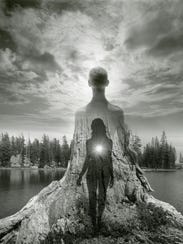
Jerry Uelsmann's "Myth of the Tree" (Photo: Jerry Uelsmann)
Uelsmann’s Gainesville darkroom, it turns out, isn’t just where he makes his influential photo montages. It’s a jumping off point — a place where he disappears for a while and leaves the normal, rational world behind.
“It’s sort of a meditative thing,” the artist explains. “There’s a magical quality.
"And the better images go to the fringes of your consciousness where you can’t intellectually define what’s going on. It’s a subconscious thing, almost.”
Visitors can walk through those strange, dream-like worlds in a new exhibit that opened Jan. 11 at Rauschenberg Gallery in south Fort Myers. It’s the artist’s biggest retrospective in years — and one of the few that’s happened in Florida.
The exhibit shines a spotlight on a groundbreaking artist sometimes called the “Godfather of Photoshop,” Dellinger says. Uelsmann has been combining and manipulating photos into new, otherworldly images for more than five decades now, long before the computer program Photoshop made it easy. And he does it the hard way — in an old-fashioned photographic darkroom.
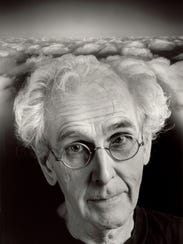
A self portrait of Jerry Uelsmann (Photo: Special to The News-Press)
Uelsmann’s work has been shown in more than 100 solo exhibits worldwide, including the 1967 exhibit at New York City’s Museum of Modern Art that launched the artist’s career.
“There’s no question that he’s part of the historical canon,” Dellinger says. “He’s taught in art history classes and photography classes.”
Uelsmann’s photo manipulations represented a disruptive force in the 1960s art world, Dellinger says. It was a big departure from the work of Ansel Adams and other “straight photography” that simply captured the world as it existed.
Uelsmann, instead, created all new worlds by superimposing several photographic negatives — sometimes a dozen at a time — one on top of the other, using enlargers and other photography equipment.
“There was a break with what was accepted,” Dellinger says. “With what was the norm.”
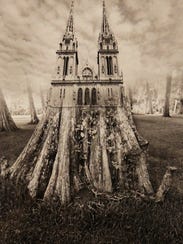
Jerry Uelsmann often uses trees and roots in his surreal photography to represent nature and growth. (Photo: Jerry Uelsmann)
The result: Hallucinatory, surreal scenes that have more in common with Dali and Magritte than Adams.
In Uelsmann’s world, a forest of trees floats high in the sky, roots and all. A ghostly shadow haunts a tunnel. Cupped hands transform into a window overlooking a house in the clouds.
“These images are about precognition,” Dellinger says. “It’s about these things that are very dream-like and illusionistic.”
The artist doesn’t like to tell people what, exactly, those images are supposed to represent or mean. Indeed, most of his photos don’t even have titles.
But a few of them do. And Uelsmann is happy to talk about their origins.
“Myth of the Tree,” for example, shows a ghostly male figure emerging from a tree trunk and staring at a tree-lined lake. A shadowy woman stands inside the trunk with a shining sun blazing inside her chest.
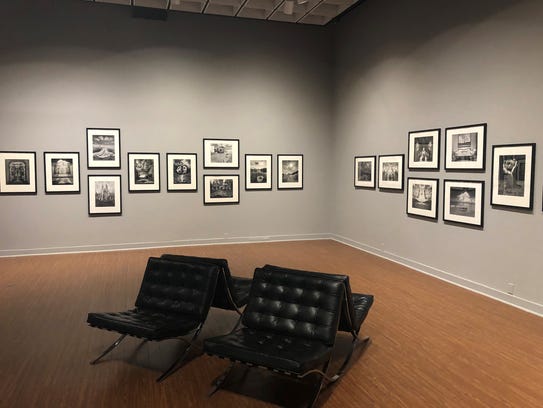
Part of the Jerry Uelsmann at Bob Rauschenberg Gallery (Photo: Jerry Uelsmann)
Trees come up often in Uelsmann’s work — especially trees that transform into people or houses or other buildings. He loves the metaphor and its connection to the Tree of Life and classic folklore and myth.
“It’s a very open-ended metaphor for growing and everything else,” he says.
But Uelsmann admits he doesn’t always know where those images are going until he’s finished with each piece. He can spend days combining multiple negatives in his darkroom — he calls it his Confluence Room — until something magical happens.
“When I’m working on these things, what I find fascinating is many times my conscious mind is dealing with technical issues,” he says. “And yet later when I look at it, it was a leap of faith to think I could blend this tree into this figure. And afterward, I added this female figure that’s in there and added the light from within.”
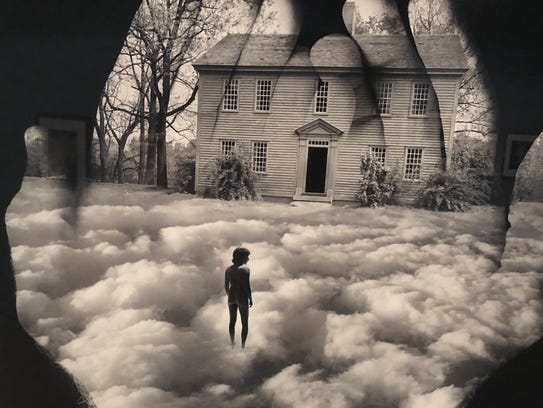
An untitled photo by Jerry Uelsmann (Photo: Jerry Uelsmann)
Another piece in the exhibit, the self portrait “Questions of Self,” shows a forlorn Uelsmann staring out of a window, a negative image of himself reflected in the glass.
Uelsmann created the photo after an emotionally traumatic period in his life — he declines to talk about it on the record — when he was reeling and shocked and questioning what he would do next.
Such negative photographic images appear often in his work, too.
“It just suggests that there’s a complex layering,” Uelsmann says. “We’re complex creatures. There’s a sort of surface awareness of who we are, and then there are these levels that are below consciousness that are immense and endless."
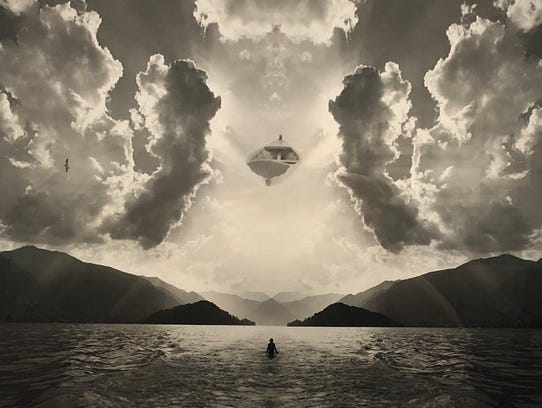
An untitled photo by Jerry Uelsmann (Photo: Jerry Uelsmann)
The resulting images are beautiful and endlessly fascinating, Dellinger says. “When you see these photographs in person, they’re just stunning.”
Even more impressive: Those photos are the result of old-school darkroom photography with its chemicals and black lights and photographic paper. Despite being the Godfather of Photoshop and an influence on montage art made through that computer program, Uelsmann says he doesn’t have any interest in using a computer to make his art.
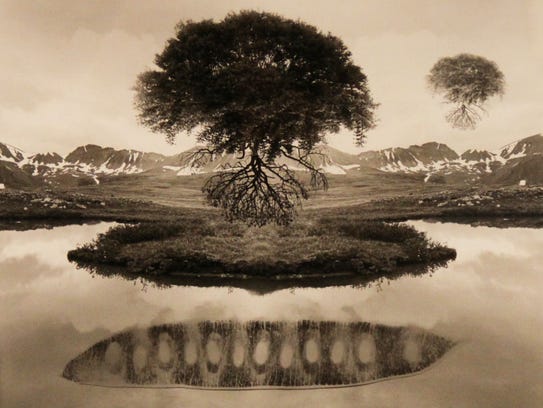
An untitled photo by Jerry Uelsmann (Photo: Jerry Uelsmann)
But don’t get him wrong: He doesn’t have anything against Photoshop and considers it one of several tools that artists can use. “They’re different ways to create meaningful images that resonate with audiences,” he says.
It’s just that he’s 83 years old, he says, and he’s comfortable doing things the way he’s always done them. Plus there’s a steep learning curve with Photoshop.
“I don’t foresee myself doing that at this time," he says. "The manuals are insane.”
Connect with this reporter: Charles Runnells (Facebook), @charlesrunnells (Twitter), @crunnells1 (Instagram)
If you go
What: “Jerry Uelsmann: Imagemaker” art exhibit
When: Jan. 11-March 24
Where: Bob Rauschenberg Gallery at Florida SouthWestern State College, 8099 College Parkway S.W., Building L, south Fort Myers
Admission: Free
Gallery hours: 10 a.m.to 4 p.m. Monday through Friday, 11 a.m. to 3 p.m. Saturday
Info: 489-9313 or rauschenberggallery.com
Godfather of Photoshop: Art icon Jerry Uelsmann's dream-like worlds visit Fort Myers gallery
Posted on Jan 24, 2018
A giant floating eye stares into a lonely tunnel. A tree’s roots grow skyward until they become a towering cathedral. A door opens in a huge boulder to reveal stairs going up to … somewhere.
These strange scenes don’t exist in the real world, Jade Dellinger says. But in the hands of legendary photographer Jerry Uelsmann, they certainly FEEL like it.
And that goes for the artist, too.
“It’s sort of an escape for him,” says Dellinger, director of Bob Rauschenberg Gallery at Florida SouthWestern State College. “It’s about visiting these other worlds.”

Jerry Uelsmann's "Myth of the Tree" (Photo: Jerry Uelsmann)
Uelsmann’s Gainesville darkroom, it turns out, isn’t just where he makes his influential photo montages. It’s a jumping off point — a place where he disappears for a while and leaves the normal, rational world behind.
“It’s sort of a meditative thing,” the artist explains. “There’s a magical quality.
"And the better images go to the fringes of your consciousness where you can’t intellectually define what’s going on. It’s a subconscious thing, almost.”
Visitors can walk through those strange, dream-like worlds in a new exhibit that opened Jan. 11 at Rauschenberg Gallery in south Fort Myers. It’s the artist’s biggest retrospective in years — and one of the few that’s happened in Florida.
The exhibit shines a spotlight on a groundbreaking artist sometimes called the “Godfather of Photoshop,” Dellinger says. Uelsmann has been combining and manipulating photos into new, otherworldly images for more than five decades now, long before the computer program Photoshop made it easy. And he does it the hard way — in an old-fashioned photographic darkroom.

A self portrait of Jerry Uelsmann (Photo: Special to The News-Press)
Uelsmann’s work has been shown in more than 100 solo exhibits worldwide, including the 1967 exhibit at New York City’s Museum of Modern Art that launched the artist’s career.
“There’s no question that he’s part of the historical canon,” Dellinger says. “He’s taught in art history classes and photography classes.”
Uelsmann’s photo manipulations represented a disruptive force in the 1960s art world, Dellinger says. It was a big departure from the work of Ansel Adams and other “straight photography” that simply captured the world as it existed.
Uelsmann, instead, created all new worlds by superimposing several photographic negatives — sometimes a dozen at a time — one on top of the other, using enlargers and other photography equipment.
“There was a break with what was accepted,” Dellinger says. “With what was the norm.”

Jerry Uelsmann often uses trees and roots in his surreal photography to represent nature and growth. (Photo: Jerry Uelsmann)
The result: Hallucinatory, surreal scenes that have more in common with Dali and Magritte than Adams.
In Uelsmann’s world, a forest of trees floats high in the sky, roots and all. A ghostly shadow haunts a tunnel. Cupped hands transform into a window overlooking a house in the clouds.
“These images are about precognition,” Dellinger says. “It’s about these things that are very dream-like and illusionistic.”
The artist doesn’t like to tell people what, exactly, those images are supposed to represent or mean. Indeed, most of his photos don’t even have titles.
But a few of them do. And Uelsmann is happy to talk about their origins.
“Myth of the Tree,” for example, shows a ghostly male figure emerging from a tree trunk and staring at a tree-lined lake. A shadowy woman stands inside the trunk with a shining sun blazing inside her chest.

Part of the Jerry Uelsmann at Bob Rauschenberg Gallery (Photo: Jerry Uelsmann)
Trees come up often in Uelsmann’s work — especially trees that transform into people or houses or other buildings. He loves the metaphor and its connection to the Tree of Life and classic folklore and myth.
“It’s a very open-ended metaphor for growing and everything else,” he says.
But Uelsmann admits he doesn’t always know where those images are going until he’s finished with each piece. He can spend days combining multiple negatives in his darkroom — he calls it his Confluence Room — until something magical happens.
“When I’m working on these things, what I find fascinating is many times my conscious mind is dealing with technical issues,” he says. “And yet later when I look at it, it was a leap of faith to think I could blend this tree into this figure. And afterward, I added this female figure that’s in there and added the light from within.”

An untitled photo by Jerry Uelsmann (Photo: Jerry Uelsmann)
Another piece in the exhibit, the self portrait “Questions of Self,” shows a forlorn Uelsmann staring out of a window, a negative image of himself reflected in the glass.
Uelsmann created the photo after an emotionally traumatic period in his life — he declines to talk about it on the record — when he was reeling and shocked and questioning what he would do next.
Such negative photographic images appear often in his work, too.
“It just suggests that there’s a complex layering,” Uelsmann says. “We’re complex creatures. There’s a sort of surface awareness of who we are, and then there are these levels that are below consciousness that are immense and endless."

An untitled photo by Jerry Uelsmann (Photo: Jerry Uelsmann)
The resulting images are beautiful and endlessly fascinating, Dellinger says. “When you see these photographs in person, they’re just stunning.”
Even more impressive: Those photos are the result of old-school darkroom photography with its chemicals and black lights and photographic paper. Despite being the Godfather of Photoshop and an influence on montage art made through that computer program, Uelsmann says he doesn’t have any interest in using a computer to make his art.

An untitled photo by Jerry Uelsmann (Photo: Jerry Uelsmann)
But don’t get him wrong: He doesn’t have anything against Photoshop and considers it one of several tools that artists can use. “They’re different ways to create meaningful images that resonate with audiences,” he says.
It’s just that he’s 83 years old, he says, and he’s comfortable doing things the way he’s always done them. Plus there’s a steep learning curve with Photoshop.
“I don’t foresee myself doing that at this time," he says. "The manuals are insane.”
Connect with this reporter: Charles Runnells (Facebook), @charlesrunnells (Twitter), @crunnells1 (Instagram)
If you go
What: “Jerry Uelsmann: Imagemaker” art exhibit
When: Jan. 11-March 24
Where: Bob Rauschenberg Gallery at Florida SouthWestern State College, 8099 College Parkway S.W., Building L, south Fort Myers
Admission: Free
Gallery hours: 10 a.m.to 4 p.m. Monday through Friday, 11 a.m. to 3 p.m. Saturday
Info: 489-9313 or rauschenberggallery.com
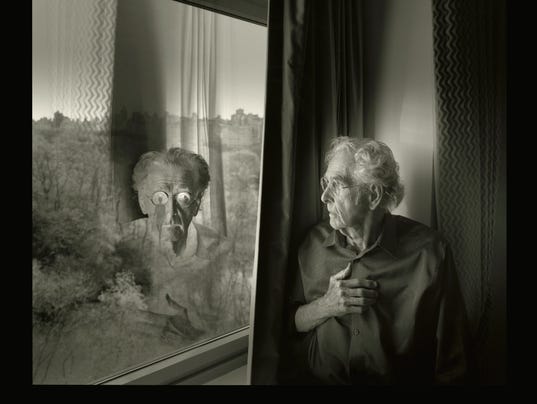


Comments (0)
Add a Comment